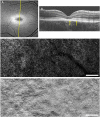Stargardt disease: clinical features, molecular genetics, animal models and therapeutic options
- PMID: 27491360
- PMCID: PMC5256119
- DOI: 10.1136/bjophthalmol-2016-308823
Stargardt disease: clinical features, molecular genetics, animal models and therapeutic options
Abstract
Stargardt disease (STGD1; MIM 248200) is the most prevalent inherited macular dystrophy and is associated with disease-causing sequence variants in the gene ABCA4 Significant advances have been made over the last 10 years in our understanding of both the clinical and molecular features of STGD1, and also the underlying pathophysiology, which has culminated in ongoing and planned human clinical trials of novel therapies. The aims of this review are to describe the detailed phenotypic and genotypic characteristics of the disease, conventional and novel imaging findings, current knowledge of animal models and pathogenesis, and the multiple avenues of intervention being explored.
Keywords: Dystrophy; Imaging; Retina.
Published by the BMJ Publishing Group Limited. For permission to use (where not already granted under a licence) please go to http://www.bmj.com/company/products-services/rights-and-licensing/.
Conflict of interest statement
Conflicts of Interest: None declared.
Figures


References
Publication types
MeSH terms
Substances
Grants and funding
LinkOut - more resources
Full Text Sources
Other Literature Sources
Medical
